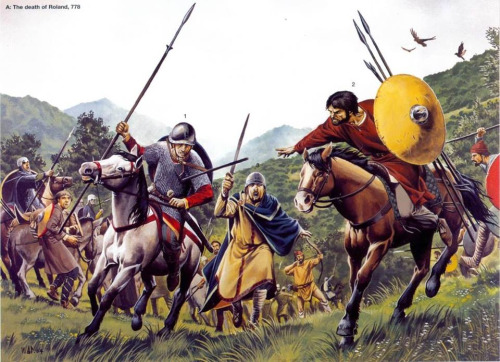15 August 778
The events that took place in a high gorge in the western Pyrenees one August day in 778 were turned three centuries later into one of the most famous European epic poems, the Chanson de Roland, the ‘Song of Roland’. The author of the poem is not known, and indeed the historical circumstances to which the poem alludes are sketchy in the extreme. The poem has Roland as a brave Christian hero, betrayed by his jealous step-father Ganelon during a campaign in Spain by the Frankish king Charlemagne. As the Frankish army returns through the mountains to France, Roland and the rearguard are ambushed by thousands of pagans (Muslims) and the nobles are slaughtered. Roland dies, sword in hand, and his soul is taken to heaven by angels. Ganelon is later caught by Charlemagne, tortured, and finally, still alive, torn to pieces by four horses.
There is enough truth in the epic to indicate that over 300 years an oral tradition passed down an embellished Christian version of the death of Roland, prefect of the Breton March, during the withdrawal of Charlemagne’s army from an unsuccessful campaign against the Muslim state of al-Andalus that dominated most of Spain. The poem itself is a fantasy, for little is known of the circumstances of the defeat of Charlemagne’s rearguard at or near the town of Roncesvalles in the present-day Basque country, though it was certainly not a showdown between Islam and Christianity, as the Chanson suggests. The first medieval accounts of Charlemagne’s reign passed over the defeat. Only the ninth-century biography of Charlemagne, the Vita Karoli, written by the monk Einhard, has a few hundred words about the ambush. There remains considerable uncertainty about the site of the battle, who organized the ambush, and even if the ‘Hruodlandus’ mentioned in the text really is ‘Roland’. For the details of the ambush itself, this is the only real record. The one thing that seems reasonably certain is that the Franks caught by the men concealed on the forested mountainsides were massacred.
The background to the Roncesvalles ambush gives at least some clues as to what might have happened. In 777, the rulers of small Muslim states in eastern Spain, led by Suleiman al-Arabi, governor of Barcelona and Girona, sent an embassy to Charlemagne in Paderborn asking him to help them in their struggle against the Muslim ruler of al-Andalus, Abd al-Rahman. There were hints that Charlemagne might gain territory or vassals if he helped them. Since the Frankish kings had spent decades slowly pushing back the Muslim control of southwestern France, Charlemagne was probably attracted to the idea of establishing a Spanish March in the areas of the Pyrenees. He mustered a major army from across his dominions and marched in two columns, one west, and one east of the mountain chain. They met up and moved on Zaragoza, whose ruler, Al-Husein, went back on his promise to co-operate with the Franks. Charlemagne spent a fruitless few weeks trying to besiege the city but abandoned the attempt when he was warned that the troublesome Saxons were again threatening the eastern part of his kingdom. He took Suleiman al-Arabi as a hostage and set off with his army through the passes that linked the Basque territories of northeastern Spain with Gascony, in southwest France.
According to the surviving annals, Charlemagne had a difficult retreat. Some sources suggest that a Muslim attack was made to free Suleiman and other hostages. When Charlemagne reached Pamplona, he found the Basque and Muslim inhabitants no longer willing to submit to him, so he captured and sacked the city. By the time his army began to wind its way through the pass across the Pyrenees, the local Basques and probably some Arab allies had plenty of reason to want revenge on the Franks. The rearguard was their target as it contained the baggage train and treasure taken from Charlemagne’s temporary Spanish allies. Einhard’s account describes a country where ambushes were everyday affairs, easy to mount ‘by reason of the thick forests’. As the rearguard entered the pass (the exact one is not certain), they were suddenly assailed by a more mobile and lightly armoured enemy. They were hurled down ‘to the very bottom of the valley’, where they were slaughtered as they struggled in heavy armour and unhelpful terrain against an enemy evidently familiar with the advantages of deception. Before any help could come from the rest of the army, the ambushers melted away in the dusk, bearing all the booty with them. Einhard confirms that pursuit was useless: ‘not the least clue could be had to their whereabouts’.
The story consists of little more than a classic opportunistic ambush that reversed the odds against what was certainly a large and powerful army. Charlemagne did not return to Spain for another twenty years, but the Carolingian Empire did eventually construct a Hispanic March to end any further encroachment from Muslim Spain. The death of Roland, if indeed it was he, is supposed to have weighed heavily upon Charlemagne. A chronicle in 829, the first time the defeat at Roncesvalles was admitted, claimed that ‘this wound that the King received in Spain almost totally erased from his heart the memory of his success there’. The ambush has since become the famous climax in the Chanson de Roland, the founding work of French literature, enjoying an unexpected afterlife long after any of its details could be recalled. In the poem, Charlemagne takes his revenge on the pagans, but in reality the ambush remained unavenged, a brief moment of triumph for the unruly Basques against the main power of Christian Europe.
